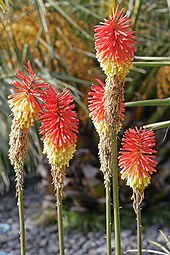 The Red Hot Poker flowers in Huxley's garden were "so passionately alive that they seemed to be standing on the very brink of utterance".
The Red Hot Poker flowers in Huxley's garden were "so passionately alive that they seemed to be standing on the very brink of utterance".
Synopsis[edit]
After a brief overview of research into mescaline, Huxley recounts that he was given 4/10 of a gram at 11:00 am one day in May 1953. Huxley writes that he hoped to gain insight into extraordinary states of mind and expected to see brightly coloured visionary landscapes. When he only sees lights and shapes, he puts this down to being a bad visualiser; however, he experiences a great change in his perception of the external world.[32]
By 12:30 pm, a vase of flowers becomes the "miracle, moment by moment, of naked existence". The experience, he asserts, is neither agreeable nor disagreeable, but simply "is". He likens it to Meister Eckhart's "istigheit" or "is-ness", and Plato's "Being" but not separated from "Becoming". He feels he understands the Hindu concept of Satchitananda, as well as the Zenkoan that, "the dharma body of the Buddha is in the hedge" and Buddhist suchness. In this state, Huxley explains he didn't have an "I", but instead a "not-I". Meaning and existence, pattern and colour become more significant than spatial relationships and time. Duration is replaced by a perpetual present.[33]
Reflecting on the experience afterwards, Huxley finds himself in agreement with philosopher C. D. Broad that to enable us to live, the brain and nervous system eliminate unessential information from the totality of the Mind at Large.[34]
In summary, Huxley writes that the ability to think straight is not reduced while under the influence of mescaline, visual impressions are intensified, and the human experimenter will see no reason for action because the experience is so fascinating.[35]
Temporarily leaving the chronological flow, he mentions that four or five hours into the experience he was taken to the World's Biggest Drug Store (WBDS), where he was presented with books on art. In one book, the dress in Botticelli's Judith provokes a reflection on drapery as a major artistic theme as it allows painters to include the abstract in representational art, to create mood, and also to represent the mystery of pure being.[36]Huxley feels that human affairs are somewhat irrelevant whilst on mescaline and attempts to shed light on this by reflecting on paintings featuring people.[37] Cézanne's Self-portrait with a straw hat seems incredibly pretentious, while Vermeer's human still lifes (also, the Le Nain brothers and Vuillard) are the nearest to reflecting this not-self state.[38]
For Huxley, the reconciliation of these cleansed perceptions with humanity reflects the age old debate between active and contemplative life, known as the way of Martha and the way of Mary. As Huxley believes that contemplation should also include action and charity, he concludes that the experience represents contemplation at its height, but not its fullness. Correct behaviour and alertness are needed. Nonetheless, Huxley maintains that even quietistic contemplation has an ethical value, because it is concerned with negative virtues and acts to channel the transcendent into the world.[39]
After listening to Mozart's C-Minor Piano Concerto, Gesualdo's madrigals and Alban Berg'sLyric Suite,[40] Huxley heads into the garden. Outside, the garden chairs take on such an immense intensity that he fears being overwhelmed; this gives him an insight into madness. He reflects that spiritual literature, including the works of Jakob Böhme, William Law and theTibetan Book of the Dead, talk of these pains and terrors. Huxley speculates that schizophrenia is the inability to escape from this reality into the world of common sense and thus help would be essential.[41]
After lunch and the drive to the WBDS he returns home and to his ordinary state of mind. His final insight is taken from Buddhist scripture: that within sameness there is difference, although that difference is not different from sameness.[42]
The book finishes with Huxley's final reflections on the meaning of his experience. Firstly, the urge to transcend one's self is universal through times and cultures (and was characterised by H. G. Wells as The Door in the Wall).[43] He reasons that better, healthier "doors" are needed than alcohol and tobacco. Mescaline has the advantage of not provoking violence in takers, but its effects last an inconveniently long time and some users can have negative reactions.Ideally, self-transcendence would be found in religion, but Huxley feels that it is unlikely that this will ever happen. Christianity and mescaline seem well-suited for each other; the Native American Church for instance uses the drug as a sacrament, where its use combines religious feeling with decorum.[44]
In the field of religion, Huxley’s friend and spiritual mentor, the Vedantic monk Swami Prabhavananda, thought that mescaline was an illegitimate path to enlightenment, a "deadly heresy" as Christopher Isherwood put it.[24] Martin Buber, the Jewish religious philosopher, attacked Huxley's notion that mescaline allowed a person to participate in "common being", and held that the drug ushered users "merely into a strictly private sphere". Philosophically, Buber believed the drug experiences to be holidays "from the person participating in the community of logos and cosmos—holidays from the very uncomfortable reminder to verify oneself as such a person." For Buber man must master, withstand and alter his situation, or even leave it, "but the fugitive flight out of the claim of the situation into situationlessness is no legitimate affair of man."[57]
Huxley concludes that mescaline is not enlightenment or the Beatific vision, but a "gratuitous grace" (a term taken fromThomas Aquinas' Summa Theologica).[45] It is not necessary but helpful, especially so for the intellectual, who can become the victim of words and symbols. Although systematic reasoning is important, direct perception has intrinsic value too. Finally, Huxley maintains that the person who has this experience will be transformed for the better.



No comments:
Post a Comment